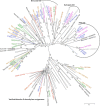Complete sequencing of Novosphingobium sp. PP1Y reveals a biotechnologically meaningful metabolic pattern
- PMID: 24884518
- PMCID: PMC4059872
- DOI: 10.1186/1471-2164-15-384
Complete sequencing of Novosphingobium sp. PP1Y reveals a biotechnologically meaningful metabolic pattern
Abstract
Background: Novosphingobium sp. strain PP1Y is a marine α-proteobacterium adapted to grow at the water/fuel oil interface. It exploits the aromatic fraction of fuel oils as a carbon and energy source. PP1Y is able to grow on a wide range of mono-, poly- and heterocyclic aromatic hydrocarbons. Here, we report the complete functional annotation of the whole Novosphingobium genome.
Results: PP1Y genome analysis and its comparison with other Sphingomonadal genomes has yielded novel insights into the molecular basis of PP1Y's phenotypic traits, such as its peculiar ability to encapsulate and degrade the aromatic fraction of fuel oils. In particular, we have identified and dissected several highly specialized metabolic pathways involved in: (i) aromatic hydrocarbon degradation; (ii) resistance to toxic compounds; and (iii) the quorum sensing mechanism.
Conclusions: In summary, the unraveling of the entire PP1Y genome sequence has provided important insight into PP1Y metabolism and, most importantly, has opened new perspectives about the possibility of its manipulation for bioremediation purposes.
Figures




Similar articles
-
The marine isolate Novosphingobium sp. PP1Y shows specific adaptation to use the aromatic fraction of fuels as the sole carbon and energy source.Microb Ecol. 2011 Apr;61(3):582-94. doi: 10.1007/s00248-010-9786-3. Epub 2011 Jan 22. Microb Ecol. 2011. PMID: 21258788
-
Comparative genomic analysis of six bacteria belonging to the genus Novosphingobium: insights into marine adaptation, cell-cell signaling and bioremediation.BMC Genomics. 2013 Jun 28;14:431. doi: 10.1186/1471-2164-14-431. BMC Genomics. 2013. PMID: 23809012 Free PMC article.
-
De novo sequencing and assembly of the whole genome of Novosphingobium sp. strain PP1Y.J Bacteriol. 2011 Aug;193(16):4296. doi: 10.1128/JB.05349-11. Epub 2011 Jun 17. J Bacteriol. 2011. PMID: 21685292 Free PMC article.
-
Genome sequence of benzo(a)pyrene-degrading bacterium Novosphingobium pentaromativorans US6-1.J Bacteriol. 2012 Feb;194(4):907. doi: 10.1128/JB.06476-11. J Bacteriol. 2012. PMID: 22275104 Free PMC article.
-
[Recent advances in Sphingobium sp. SYK-6 for lignin aromatic compounds degradation--a review].Wei Sheng Wu Xue Bao. 2014 Aug 4;54(8):854-67. Wei Sheng Wu Xue Bao. 2014. PMID: 25345016 Review. Chinese.
Cited by
-
The complete 12 Mb genome and transcriptome of Nonomuraea gerenzanensis with new insights into its duplicated "magic" RNA polymerase.Sci Rep. 2016 Dec 21;6(1):18. doi: 10.1038/s41598-016-0025-0. Sci Rep. 2016. PMID: 28442708 Free PMC article.
-
Human Microbiome Acquisition and Bioinformatic Challenges in Metagenomic Studies.Int J Mol Sci. 2018 Jan 27;19(2):383. doi: 10.3390/ijms19020383. Int J Mol Sci. 2018. PMID: 29382070 Free PMC article. Review.
-
Machine Learning Approach Reveals the Assembly of Activated Sludge Microbiome with Different Carbon Sources during Microcosm Startup.Microorganisms. 2021 Jun 25;9(7):1387. doi: 10.3390/microorganisms9071387. Microorganisms. 2021. PMID: 34202381 Free PMC article.
-
Draft Genome Sequence of the Carbofuran-Mineralizing Novosphingobium sp. Strain KN65.2.Genome Announc. 2015 Jul 9;3(4):e00764-15. doi: 10.1128/genomeA.00764-15. Genome Announc. 2015. PMID: 26159535 Free PMC article.
-
Bioconversion of 4-hydroxyestradiol by extradiol ring-cleavage dioxygenases from Novosphingobium sp. PP1Y.Sci Rep. 2023 Feb 1;13(1):1835. doi: 10.1038/s41598-023-28908-2. Sci Rep. 2023. PMID: 36725873 Free PMC article.
References
-
- King RW. Petroleum: its composition, analysis and processing. Occup Med. 1988;3:409–430. - PubMed
Publication types
MeSH terms
LinkOut - more resources
Full Text Sources
Other Literature Sources
Molecular Biology Databases

